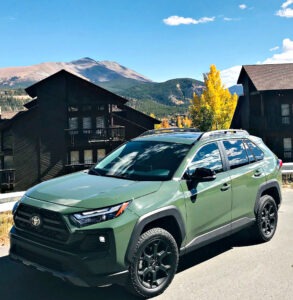Happy 30th birthday to the Toyota RAV4. It’s not only lasted for three decades, the RAV4 has resided at or near the top of the list of compact crossover SUVs during that long time span.

Introduced in Japan and Europe in 1994, two years later the RAV4 became an instant hit in the U.S. market thanks to its many fine qualities.
Going by the numbers, during the past decade the RAV4 has been the most popular compact SUV. Entering 2024, it had historic sales of more than 5.2 million after an incredible 434,943 sold in 2023, the second largest in the vehicle’s long history. It marked the sixth time in seven years RAV4 sales have exceeded 400,000.
The RAV4’s primary competitor – Honda CRV – had sales of 361,457 in 2023. But no other rivals are even close. Last year the heralded Mazda CX-5 had sales of 153,808 and the Kia Sportage finished with 140,780 in sales.
Despite its huge success, Toyota did some tinkering with the RAV4 the past few years. The biggest news has been adding a hybrid and a plug-in hybrid (RAV4 Prime) to the lineup. This review is focused on the gas-powered 2024 Toyota RAV4.
Because the RAV4 was getting a little behind the times in some areas, Toyota did a complete redesign in 2019, making improvements in performance, exterior styling, and adding more technological and safety features. There were no changes for the 2024 RAV4.
One of the RAV4’s greatest qualities is its cargo space. In fact, the cargo area of 37.5 cubic feet is so large that one might think the RAV4 is a midsize SUV. Drop the second row down and the space expands to 69.8 cubes, one of the largest in the class, allowing the RAV4 to make sizable hardware store purchases.
Slotted in the Toyota SUV lineup between the three-row Highlander and the subcompact C-HR, the RAV4 has considerable variety, offered in seven trim levels (LE, XLE, SE, Woodland Edition, XLE Premium, XSE, Limited).
One area that could use some improvement is performance. We drove the RAV4 in the Colorado Rockies for a week and at times the RAV4 seemed overmatched. Granted, many vehicles are overmatched by the majestic Rockies, which reach a peak of 14,400 elevation.
Although the engine has been improved in recent years, several other compact crossover SUVs provide better performance and a more powerful engine as an upgrade. The lone RAV4 engine is a 2.5-liter, four-cylinder that generates 203 horsepower and 184 pound-feet of torque.

The engine is a bit sluggish at times and goes 0-60 mph in 8.1 seconds. It does offer a switch to Sport mode that was helpful in the mountain passes and an Eco mode for saving gas during around-town driving. The fuel economy ranges from 27-35 mpg.
We found the steering to be slightly vague and the overall handling modest. An array of safety features included lane keeping assist, lane departure mitigation, forward collision mitigation with automatic braking, and adaptive cruise control.
2024 TOYOTA RAV4
- Performance: 2.5-liter, four-cylinder, 203 horsepower
- Mileage estimate: 27-35 mpg
- Price estimate: $28,700 to $38,400
- Warranty: 3 years/36,000 miles; Drivetrain: 5 years/60,000 miles; Roadside Assistance: 2 years/unlimited; Corrosion: 5 years/unlimited
Because we aren’t huge fans of excessive technology that often leaves drivers confused and distracted, the standard 8-inch touchscreen with a mix of control knob placements worked well by our standards. However, the touchscreen’s graphics appear dated and need some upgrading. The infotainment system includes a 4G LTE mobile hotspot and wireless Apple CarPlay and Android Auto capability.
Seating room is solid in both the front and back rows, although three adults in the back is not ideal for any long trips.
Judging by the current sales figures heading into October, the 2024 RAV4 remains quite popular. The small SUV continues to be a huge hit for Toyota and is one rivals are still looking to overtake.
Weidel on Wheels is featured regularly on www.tahoeskiworld.com. Auto writer Jeffrey Weidel can be reached at [email protected]. Follow him on Twitter at @jeffweidel.